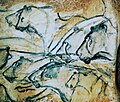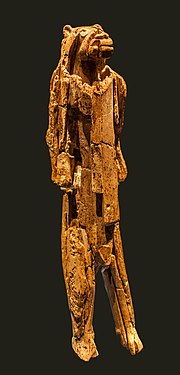The Aurignacian (/ɔːrɪɡˈneɪʃən/) is an archaeological industry of the Upper Paleolithic associated with Early European modern humans (EEMH) lasting from...
33 KB (3,356 words) - 22:16, 21 October 2024
The Levantine Aurignacian (35,000-29,000 BP, calibrated, 32,000-26,000 BP, non-calibrated) is an Upper Paleolithic culture of the Near-Eastern Levant...
10 KB (882 words) - 14:31, 8 July 2023
Cro-Magnon (section Aurignacian)
produced Upper Palaeolithic cultures, the first major one being the Aurignacian, which was succeeded by the Gravettian by 30,000 years ago. The Gravettian...
154 KB (19,167 words) - 14:44, 23 October 2024
differ greatly from the Aurignacian artifacts. The Kebaran is preceded by the final phase of the Upper Paleolithic Levantine Aurignacian (also known as the...
10 KB (916 words) - 08:25, 19 November 2024
Paleolithic Europe (section Aurignacian)
followed by the Aurignacian. The origins of this culture can be located in Eastern Europe, in what is now Bulgaria (proto-Aurignacian) and Hungary (first...
22 KB (2,237 words) - 06:36, 13 September 2024
frequent than that of the later Aurignacian, while antler tools have not been found. It is followed by the Aurignacian industry. Scholars who question...
14 KB (1,359 words) - 04:20, 4 June 2024
relates the European Châtelperronian. But the Aurignacian complex (Protoaurignacian and Early Aurignacian) with its famous Cave art seems to correspond...
18 KB (2,140 words) - 00:46, 23 June 2024
Venus of Hohle Fels (category Aurignacian)
dated to between 42,000 and 40,000 years ago, belonging to the early Aurignacian, at the very beginning of the Upper Paleolithic, which is associated...
13 KB (1,187 words) - 04:34, 27 September 2024
(BP) and thought to be related to Levantine Emiran and younger European Aurignacian cultures. The word "Ahmarian" was adopted from the archaeological site...
9 KB (873 words) - 04:18, 4 June 2024
sculptor. The earliest undisputed examples of sculpture belong to the Aurignacian culture, which was located in Europe and southwest Asia and active at...
38 KB (4,208 words) - 06:02, 28 October 2024
as early as c. 300,000–200,000 BP. The main following period is the Aurignacian (c. 43,000–28,000 BP) of Homo sapiens. The culture was named after the...
20 KB (1,704 words) - 21:46, 31 May 2024
Germany, the artifacts are authentic products of the Aurignacian archaeological culture. The Aurignacian flutes were created between 43,000 and 35,000 years...
8 KB (798 words) - 03:07, 13 September 2024
and later the Levantine Aurignacian culture (formerly called Antelian), still of Levalloise tradition but with some Aurignacian influences. According to...
6 KB (549 words) - 08:27, 22 June 2024
Paleolithic Levantine Aurignacian (formerly called Antelian) period throughout the Levant. By the end of the Levantine Aurignacian, gradual changes took...
23 KB (2,455 words) - 22:41, 5 November 2024
ago, in the form of notched bones found in the context of the European Aurignacian to Gravettian and in Africa's Late Stone Age. The so-called Wolf bone...
9 KB (1,033 words) - 08:11, 31 August 2024
oldest depiction of a human being (Venus of Hohle Fels), beginning of the Aurignacian. Löwenmensch figure created in Hohlenstein-Stadel, one of the earliest...
45 KB (4,699 words) - 14:36, 10 November 2024
Jura. It is one of a number of caves where early modern humans in the Aurignacian, between 43,000 and 30,000 years ago left traces of early artwork, including...
10 KB (892 words) - 01:05, 7 October 2024
Périgordian (category Aurignacian)
that the tradition requires it to have co-existed separately from the Aurignacian industry rather than being differing industries that existed before and...
4 KB (440 words) - 05:41, 6 February 2024
Crescent: Emiran (50–40 ka) Ahmarian (46–42 ka) Baradostian (36–18 ka) Aurignacian (35–29 ka) Zarzian (20–10 ka) Kebaran (18–12.5 ka) Trialetian (16–8 ka)...
2 KB (275 words) - 17:34, 8 December 2023
Stone tool (section Mode IV: The Aurignacian Industry)
were produced in small quantities much earlier by Neanderthals. The Aurignacian culture seems to have been the first to rely largely on blades. The use...
35 KB (3,989 words) - 23:09, 3 November 2024
M.; Hedges, R.E.M. (2011). "Franchthi Cave revisited: the age of the Aurignacian in south-eastern Europe". Antiquity Magazine: 1133. Archived from the...
286 KB (25,832 words) - 15:18, 17 November 2024
then-current views on the dating and modern human associations of the Aurignacian industry in north-western Europe. However research conducted in the late...
7 KB (1,066 words) - 18:33, 21 June 2024
February 2015. Conard, Nicholas (2009). "A female figurine from the basal Aurignacian of Hohle Fels Cave in southwestern Germany". Nature. 459 (7244): 248–252...
202 KB (16,480 words) - 19:55, 19 November 2024
Paleolithic Iberia (section Aurignacian)
Aurignacian industry, sometimes called Mode 4, lasted c. 40 – 28 ka ago. The first phase, sometimes called archaic Aurignacian or proto-Aurignacian,...
31 KB (3,578 words) - 22:53, 17 August 2024
and some of these were similar to the distinctive nosed profile of the Aurignacian burins. Baradost is one of the mountains in the Zagros Mountains in Iraq...
5 KB (491 words) - 05:16, 23 July 2024
from the population represented by Goyet Q116-1, associated with the Aurignacian culture of about 35,000 BP, from the Goyet Caves in modern Belgium. It...
26 KB (2,528 words) - 15:47, 6 November 2024
traditions, chronologically: the Acheulo-Yabrudian, the Yabrudian and the Pre-Aurignacian or Amudian. The Yabrudian tradition is dominated by thick scrapers shaped...
4 KB (420 words) - 23:02, 6 June 2024
List of Stone Age art (section Aurignacian)
sub-categories. The oldest undisputed figurative art appears with the Aurignacian, about 40,000 years ago, which is associated with the earliest presence...
26 KB (2,881 words) - 19:48, 30 October 2024
archaeological industry of the European Upper Paleolithic that succeeded the Aurignacian circa 33,000 years BP. It is archaeologically the last European culture...
32 KB (3,527 words) - 21:49, 14 October 2024
during two distinct periods: the Aurignacian and the Gravettian. Most of the artwork dates to the earlier, Aurignacian, era (32,000 to 30,000 years ago)...
28 KB (3,224 words) - 06:15, 23 October 2024



















